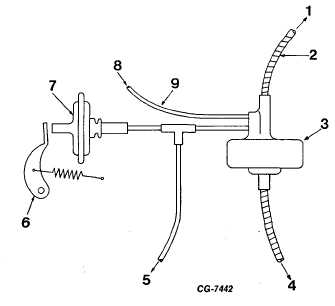|
| |
TRUCK GROUP SERVICE MANUAL
TM 5-4210-230-14&P-1
GENERAL
Figure 17 Throttle Modulator Diagram
1. To Speedometer
3. Spinner Valve Speed Sensor
2. Bleed Line Open to
4. To Transmission
Vacuum Source Below
5. To Vacuum Source
Cutoff Speed
6. Throttle Lever
7. Throttle Modulator
Bleed Line Closed To
8. To Air Cleaner
Vacuum Source Above
9. Bleed Line
Cutoff Speed
The throttle plate is held in a partially open position
during vehicle deceleration to aid combustion and provide an
acceptable exhaust emission level.
When the vehicle decelerates to the cutoff speed, the
vacuum bleed line is opened by the speed sensor, causing the
modulator to retract and allow the throttle lever to close the
throttle plate to curb idle position.
The speed sensor and throttle modulator are serviced
only as complete replacement units.
Deceleration Throttle Modulator System - 1973 California
and 1974 thru 1980 Federal Vehicles Over 6000 Lbs. GVW
The deceleration throttle modulator system (DTM)
consists basically of a vacuum operated throttle modulator unit
on the carburetor, a solenoid vacuum valve and engine speed
sensor unit (Fig. 18).
Normally an engine will emit relatively high levels of
unburned hydrocarbons during "closed throttle" deceleration.
This is because the intake of air/fuel mixture is not sufficient to
support complete combustion and the engine "misfires"
resulting in fuel being passed through the engine unburned.
The deceleration throttle modulator system overcomes this
condition by maintaining a slightly greater throttle opening (high
idle) during initial deceleration which permits intake of just
enough additional air/fuel mixture to promote combustion and
eliminate misfire.
The engine speed sensor is calibrated to activate or
deactivate (extend or retract) the throttle modulator unit at
approximately 1850 RPM engine speed.
Above 1850 RPM engine speed, the solenoid vacuum
valve is activated (held open) by electrical current from the
engine speed sensor unit. This permits manifold vacuum to act
upon the diaphragm of the throttle modulator unit extending the
modulator unit to the high idle position. Upon deceleration, the
returning carburetor throttle lever contacts the extended
modulator, thus holding the throttle in high idle position.
When engine speed drops below 1850 RPM, the speed
sensor unit deactivates the solenoid vacuum valve allowing the
valve to close and bleed the vacuum from the throttle modulator
diaphragm spring to retract the modulator unit and allow the
throttle lever to return to normal curb idle position.
For deceleration throttle modulator service instructions,
see CGES-215 Emission Control Systems.
CGES-125-T Page 11
PRINTED IN UNITED STATES OF AMERICA
|

